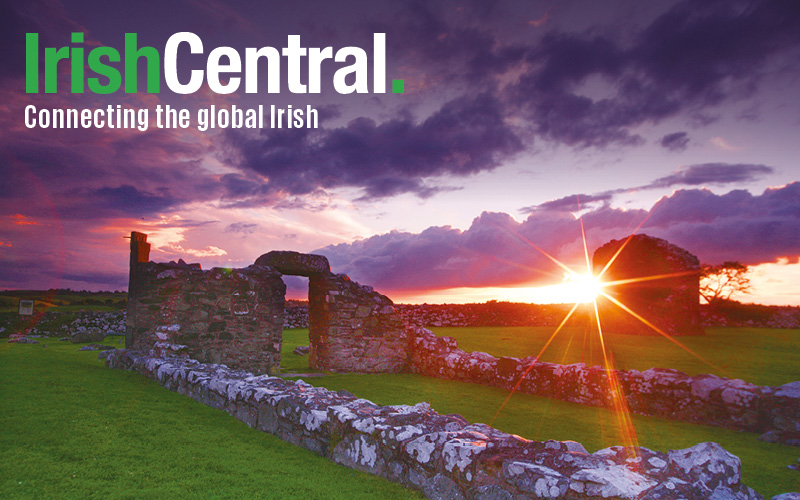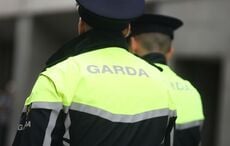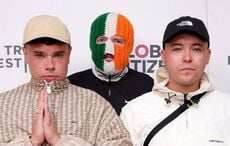Brendan Fay legally wed the love of his life, Dr. Tom Moulton, in Toronto in 2003 – back in the days when the phrase “gay marriage” was equated with fear, loathing and much worse, and was outlawed in most parts of the world, including the U.S.
What a difference 12 years makes.
Fay, the well-known Irish New Yorker and St. Patrick’s Day parade activist – co-founder of the St. Pat’s for All parade in Queens, which welcomes all marchers regardless of sexual orientation – was in his native Drogheda, Co. Louth for two weeks prior to the marriage equality vote on May 22, joining the yes campaign for non-stop lobbying, and basking in the love of a country that considered homosexuality a punishable crime up until 22 years ago.
“I’m overjoyed and overwhelmed. I’m so, so happy,” Fay told the Irish Voice during a phone interview from Drogheda on Monday evening.
“From the moment that Tom and I landed in Ireland two weeks ago, we knew something had changed dramatically. It’s a new Ireland now. Our nation has arrived.”
Fay’s role in the quest for marriage equality has been well documented. He met his husband at a Manhattan church in 1996 where the Catholic gay group Dignity was celebrating Mass and they’ve been together ever since, creating the St. Pat’s for All parade in 2000. Fay, 57, was a founder of the Civil Marriage Trail Project in 2003 which assisted American couples wishing to wed in Toronto, which at that point was the only jurisdiction in North America where marriage was legal.
Moulton, a pediatric oncologist, and Fay, an LGBT activist and documentary filmmaker, readily traveled to Ireland in the days prior to the vote to share their story and lobby for marriage equality. They were overwhelmed with the reaction.
“Everywhere we went, people wanted to share their stories with us,” said Fay. “I went to a christening in a rural part of Louth, where the no vote was supposed to be strong, and it was the opposite. We found people who wanted to talk to us about gay family members, and people who just wanted to vote yes.”
On the morning of the vote, May 22, Fay – one of seven siblings, all of whom live in Drogheda and the surrounding areas – visited his parents’ grave in the town. They were hugely supportive of him when he came out at a time when many families shunned gay members.
He returned to their grave the following day at dawn, after a sleepless, anxious night in the hours prior to the vote count. He needn’t have worried.
“It was nerve wracking, but there was so much support when we were canvassing. Still, you never know until the votes are counted,” said Fay.
“We never stopped. We went door to door every day and met people who had never voted before but said they were going to make it a point to do so in the referendum.
“They wanted to talk to us and tell us about family members and friends who are gay. There was no shame, no shame at all.
“As far back as 1998 polls had Irish in support of civil marriage for same sex couples. My father would send newspaper clippings and prayed that our day would come.”
Read more: Irish pastor’s fury over same-sex marriage tourism campaign
After watching his siblings cast their yes voteson Friday, Fay and his family gathered that night at his sister Mary’s house in Drogheda that evening to sing and dance. He was in a local café the following morning when yes campaign leaders phoned with the news that the referendum was likely to pass. Eventually he made it to Dublin where thousands gathered in the city center in joyous scenes.
“I’m still in awe. There were rainbow flags, there were Irish flags, there were people from all over. The heart and soul of Ireland came out for equality,” said Fay.
Moulton had to return to New York a week before the vote because of work commitments. He was the first one Fay called when the yes vote took an insurmountable lead and was “overjoyed,” his husband said.
Fay’s home county, Louth, returned a 64 percent yes vote, supported, he said, by politicians and people of all stripes. The thousands of Irish citizens who returned home to vote because of the lack of voting rights abroad was also heartening, Fay added.
“The diaspora participated and the diaspora made a huge difference. Ireland said welcome home to us,” he said.
“And now we will see a ripple effect. I’ve had emails from all over, from LGBT activists in different countries wanting to know how we did it, and what they can do to create the same result in their countries.”
Fay, a Catholic who lost his job as a Catholic high school religion teacher in Queens after he protested Irish gay exclusion from the New York City St. Patrick’s Day parade in 1991, encountered several no vote campaigners whose arguments, he said, were rooted in “unnecessary fear.” Some of their literature about how children would be affected by marriage equality appalled Moulton, a respected pediatrician based in the Bronx.
“There were a lot of ridiculous arguments, and I must add that there were a percentage of no voters we met who had genuine questions,” said Fay, who encountered a young priest at his Drogheda parish, St. Peter’s, telling church goers that a no vote would “protect” marriage and family.
“I attended some no meetings and put my points across,” said Fay.
Fay returned to New York on Tuesday, more buoyed than ever and ready to celebrate in his adopted city.
“Oh, for sure,” he said. “We’ll have to lead the gay pride parade [in June] with a big Irish flag to show how far we’ve come.”
New York Irish LGBT Leader Brendan Fay Overjoyed
A witness to history as marriage equality passes
Pic
Brendan Fay and his sister Mary Heeney in Drogheda on polling day.
Pic
Brendan Fay, his husband Dr. Tom Moulton and yes supporters in Drogheda.
By Debbie McGoldrick
BRENDAN Fay legally wed the love of his life, Dr. Tom Moulton, in Toronto in 2003 – back in the days when the phrase “gay marriage” was equated with fear, loathing and much worse, and was outlawed in most parts of the world, including the U.S.
What a difference 12 years makes.
Fay, the well-known Irish New Yorker and St. Patrick’s Day parade activist – co-founder of the St. Pat’s for All parade in Queens, which welcomes all marchers regardless of sexual orientation – was in his native Drogheda, Co. Louth for two weeks prior to the marriage equality vote on May 22, joining the yes campaign for non-stop lobbying, and basking in the love of a country that considered homosexuality a punishable crime up until 22 years ago.
“I’m overjoyed and overwhelmed. I’m so, so happy,” Fay told the Irish Voice during a phone interview from Drogheda on Monday evening.
“From the moment that Tom and I landed in Ireland two weeks ago, we knew something had changed dramatically. It’s a new Ireland now. Our nation has arrived.”
Fay’s role in the quest for marriage equality has been well documented. He met his husband at a Manhattan church in 1996 where the Catholic gay group Dignity was celebrating Mass and they’ve been together ever since, creating the St. Pat’s for All parade in 2000. Fay, 57, was a founder of the Civil Marriage Trail Project in 2003 which assisted American couples wishing to wed in Toronto, which at that point was the only jurisdiction in North America where marriage was legal.
Moulton, a pediatric oncologist, and Fay, an LGBT activist and documentary filmmaker, readily traveled to Ireland in the days prior to the vote to share their story and lobby for marriage equality. They were overwhelmed with the reaction.
“Everywhere we went, people wanted to share their stories with us,” said Fay. “I went to a christening in a rural part of Louth, where the no vote was supposed to be strong, and it was the opposite. We found people who wanted to talk to us about gay family members, and people who just wanted to vote yes.”
On the morning of the vote, May 22, Fay – one of seven siblings, all of whom live in Drogheda and the surrounding areas – visited his parents’ grave in the town. They were hugely supportive of him when he came out at a time when many families shunned gay members.
He returned to their grave the following day at dawn, after a sleepless, anxious night in the hours prior to the vote count. He needn’t have worried.
“It was nerve wracking, but there was so much support when we were canvassing. Still, you never know until the votes are counted,” said Fay.
“We never stopped. We went door to door every day and met people who had never voted before but said they were going to make it a point to do so in the referendum.
“They wanted to talk to us and tell us about family members and friends who are gay. There was no shame, no shame at all.
“As far back as 1998 polls had Irish in support of civil marriage for same sex couples. My father would send newspaper clippings and prayed that our day would come.”
After watching his siblings cast their yes voteson Friday, Fay and his family gathered that night at his sister Mary’s house in Drogheda that evening to sing and dance. He was in a local café the following morning when yes campaign leaders phoned with the news that the referendum was likely to pass. Eventually he made it to Dublin where thousands gathered in the city center in joyous scenes.
“I’m still in awe. There were rainbow flags, there were Irish flags, there were people from all over. The heart and soul of Ireland came out for equality,” said Fay.
Moulton had to return to New York a week before the vote because of work commitments. He was the first one Fay called when the yes vote took an insurmountable lead and was “overjoyed,” his husband said.
Fay’s home county, Louth, returned a 64 percent yes vote, supported, he said, by politicians and people of all stripes. The thousands of Irish citizens who returned home to vote because of the lack of voting rights abroad was also heartening, Fay added.
“The diaspora participated and the diaspora made a huge difference. Ireland said welcome home to us,” he said.
“And now we will see a ripple effect. I’ve had emails from all over, from LGBT activists in different countries wanting to know how we did it, and what they can do to create the same result in their countries.”
Fay, a Catholic who lost his job as a Catholic high school religion teacher in Queens after he protested Irish gay exclusion from the New York City St. Patrick’s Day parade in 1991, encountered several no vote campaigners whose arguments, he said, were rooted in “unnecessary fear.” Some of their literature about how children would be affected by marriage equality appalled Moulton, a respected pediatrician based in the Bronx.
“There were a lot of ridiculous arguments, and I must add that there were a percentage of no voters we met who had genuine questions,” said Fay, who encountered a young priest at his Drogheda parish, St. Peter’s, telling church goers that a no vote would “protect” marriage and family.
“I attended some no meetings and put my points across,” said Fay.
Fay returned to New York on Tuesday, more buoyed than ever and ready to celebrate in his adopted city.
“Oh, for sure,” he said. “We’ll have to lead the gay pride parade [in June] with a big Irish flag to show how far we’ve come.”




Comments